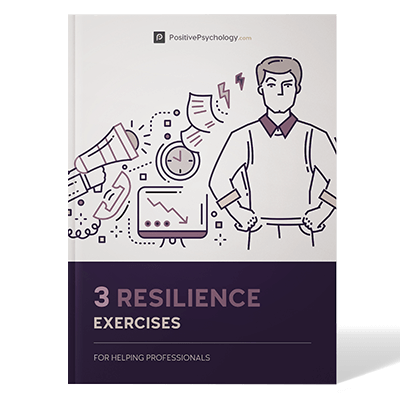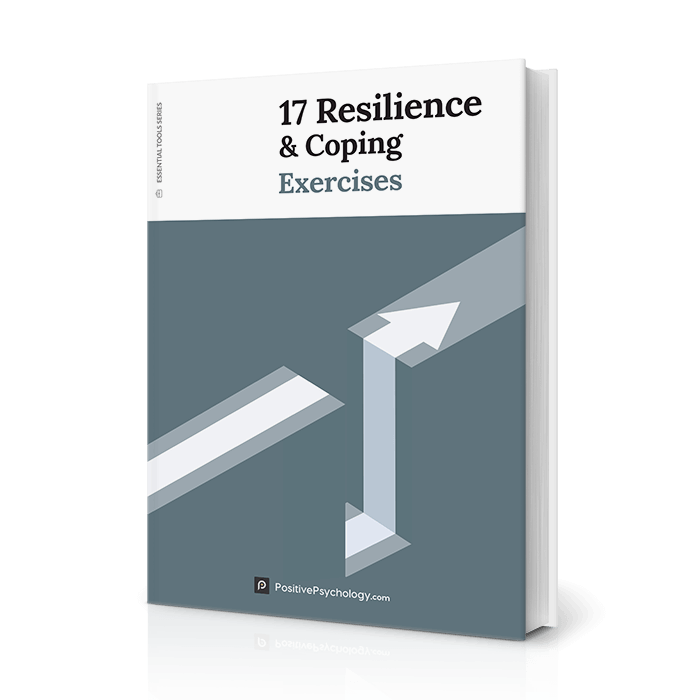10+ Coping Skills Worksheets for Adults and Youth (+ PDFs)
 No matter how mentally healthy, resilient, or happy we are, every one of us goes through times when we need to cope with something difficult.
No matter how mentally healthy, resilient, or happy we are, every one of us goes through times when we need to cope with something difficult.
Coping is something we all do, whether we do it consciously or without thinking.
That might mean watching a funny movie when you’re sad, calling a friend to help you get through a breakup, or going out for a drink after a challenging workday.
Some of the ways we cope are healthy and build resilience, while others are ways to avoid dealing with a problem or are destructive.
In this piece, we’ll provide more than 60 healthy coping strategies, explain why they’re different from negative coping methods, and provide worksheets that teach you how to cope in a more positive way.
Before you read on, we thought you might like to download our three Resilience Exercises for free. These engaging, science-based exercises will help you to effectively deal with difficult circumstances and give you the tools to improve the resilience of your clients, students or employees.
This Article Contains:
60+ Essential Positive Coping Skills
There are nearly infinite ways to cope, and we all use the methods that suit our unique personalities and needs. An activity that causes stress in one individual might help another person cope.
It doesn’t matter whether you cope like everyone else. The important thing is that you find effective coping methods that will help you to thrive and build resilience.
Below, you’ll find Blake Flannery’s master list of coping methods and skills organized into categories (2016). No matter what you need in a given moment, there is probably at least one activity listed below that will help.
Diversions
- Write, draw, paint, photography;
- Play an instrument, sing, dance, act;
- Take a shower or a bath;
- Garden;
- Take a walk, or go for a drive;
- Watch television or a movie;
- Watch cute kitten videos on YouTube;
- Play a game;
- Go shopping;
- Clean or organize your environment;
- Read;
- Take a break or vacation.
Social/Interpersonal Coping
- Talk to someone you trust;
- Set boundaries and say “no”;
- Write a note to someone you care about;
- Be assertive;
- Use humor;
- Spend time with friends and/or family;
- Serve someone in need;
- Care for or play with a pet;
- Role-play challenging situations with others;
- Encourage others.
Cognitive Coping
- Make a gratitude list;
- Brainstorm solutions;
- Lower your expectations of the situation;
- Keep an inspirational quote with you;
- Be flexible;
- Write a list of goals;
- Take a class;
- Act opposite of negative feelings;
- Write a list of pros and cons for decisions;
- Reward or pamper yourself when successful;
- Write a list of strengths;
- Accept a challenge with a positive attitude.
Tension Releasers
- Exercise or play sports;
- Engage in catharsis (yelling in the bathroom, punching a punching bag);
- Cry;
- Laugh.
Physical
- Get enough sleep;
- Eat healthy foods;
- Get into a good routine;
- Eat a little chocolate;
- Limit caffeine;
- Practice deep/slow breathing.
Spiritual
- Pray or meditate;
- Enjoy nature;
- Get involved in a worthy cause.
Limit-Setting
- Drop some involvement;
- Prioritize important tasks;
- Use assertive communication;
- Schedule time for yourself.
Suggestions from Mental Health Wellness Week

Good Coping Skills
- Practicing meditation and relaxation techniques;
- Having time to yourself;
- Engaging in physical activity or exercise;
- Reading;
- Spending time with friends;
- Finding humor;
- Spending time on your hobbies;
- Engaging in spirituality;
- Spending quality time with your pets;
- Getting a good night’s sleep;
- Eating healthy.
Negative Coping Skills
- Using drugs;
- Drinking alcohol excessively;
- Engaging in self-mutilation;
- Ignoring or bottling up feelings;
- Taking sedatives;
- Taking stimulants;
- Working too much;
- Avoiding your problems;
- Being in denial.
10 Ways to Build Resilience
Aside from using the positive coping methods, the Mental Health Wellness Week website also suggests ten tips you can put to use to strengthen your mental state and build resilience to life’s stressors:
- Build up your confidence;
- Accept compliments when they are given to you;
- Make time for your loved ones;
- Give support to others when needed and accept support from others when needed;
- Create and stick to a realistic budget;
- Volunteer in your community;
- Find ways to manage your stress on a regular basis;
- Share your burdens with others, especially those who have been through the same things;
- Identify and address your shifting moods;
- Learn how to be at peace with yourself.
It takes some work to follow these tips, but they are sure to provide you with the strength and resilience you need to navigate difficult times in your life (Mental Health Wellness Week).
If you’re still looking for more coping methods, see these suggestions for positive coping methods from mental health organization Reach Out Australia.
6 Coping Skills Worksheets for Adults

To make it easier for you, we’ve selected some of our favorites and included them below.
Growing Stronger From Trauma
Bright and colorful, this Growing Stronger From Trauma worksheet is perfect for adolescents, teens, and adults who have undergone trauma in their past. It helps the user cope with traumatic experiences by focusing on the person’s strengths.
The worksheet starts by asking the person to list five strengths he or she had before the traumatic incident. Then, the person is instructed to name strengths that helped him or her deal with the traumatic experience.
The worksheet also has the person list strengths he or she gained because of the traumatic experience, and also write about how he or she feels about those new strengths.
This worksheet can help people see the silver lining of a traumatic experience, and help them recognize the strengths that allowed them to cope with that trauma.
Emotion Masks
This worksheet encourages you to think about the ways in which you manage your feelings in front of other people. It explains that we all “wear masks” at times in order to hide our true feelings from others.
It presents some examples of imaginary masks, like acting fine when you don’t feel fine or acting angry when you really feel hurt.
Now, the creative part: At the end of the worksheet, there is space to draw the mask or masks you frequently use to hide your feelings.
This worksheet can be helpful for older kids and for adults since we all wear masks sometimes. Put your creativity and imagination to use, and think of all the times you put on a “mask” to hide how you feel.
Download the Emotion Masks worksheet and give it a try.
Coping Skills Inventory
This colorful worksheet helps you to categorize the different coping mechanisms you find most helpful. The categories include:
- Distraction;
- Grounding;
- Emotional Release;
- Self-Love;
- Thought Challenge;
- Access to Your Higher Self.
In the Challenging Thoughts section, you can list the ways that you can effectively challenge the negative and unhelpful thoughts that arise. Replacing these with positive and realistic thoughts can be a great coping tool.
The Releasing Emotions category includes actions that help you vent, express your feelings, and move on, like screaming into a pillow or punching a punching bag.
The Practicing Self-Love section is where you can write down how you practice self-compassion and show yourself appreciation, like treating yourself to a massage or writing down good things about yourself.
In the Distracting section, you can write down the skills and techniques that are most helpful for distracting you from negative and/or irrational thoughts.
The section on Tapping Into Your Best Self is for listing the things you do that help you access your ‘higher self’. For example, this may be volunteering for others or extending compassion to everyone around you.
In the grounding section, you will list the ways that you can ground yourself in the present and keep your mind focused on what is happening around you. Mindfulness techniques are perfect grounding exercises.
If you aren’t great at the skills in any of these categories, that’s okay! Just write down why you struggle with it and what you plan to do to improve your skills.
Click to see the Coping Skills Inventory worksheet.
Coping with Stress Worksheets
You’ll find two handy activities in this Coping With Stress exercise.
Part 1 instructs you to list the physiological signs and symptoms of stress, brainstorm some common responses to stress, and rate your levels of stress with each event or situation that can act as a trigger. This worksheet is a great way to begin dealing with your stress.
Part 2 will help you to brainstorm new and healthier ways to cope with your stress. It first instructs you to identify the ways in which you can and cannot control the situations that trigger you. Then, you brainstorm ways to cope with a triggering situation in the moment. Finally, you brainstorm ways to cope with the situation that reduce or eliminate your stress.
These worksheets will help you come up with a solid and thought-out plan for dealing with stress and overcoming urges to cope in unhealthy ways.
Decatastrophizing
This is a great worksheet for anyone suffering from panic or anxiety. The worksheet instructs you to imagine the worst possible outcomes, and how you’d cope if those outcomes came true.
The worksheet first instructs you to list the catastrophe you are afraid of and rate how bad you think it will be on a scale from 0 to 100. You’ll then consider the actual likelihood of that event, how awful it would be if it happened, and how you’d cope.
In the last section, you have space to list the positive and reassuring things you want to say to yourself about the catastrophe. Finally, you once again rate how bad you think the catastrophe would be.
Simply thinking through the likelihood and possible outcomes of a catastrophe you are fixated on can help you to decrease your anxiety about the potential situation.
Click here if you’d like to give this worksheet a try.
If you’re still hungry for more coping worksheets, check out our Cognitive Distortions article, which is packed with tons of resources to help you cope with any problem you may be experiencing.
Printable Coping Skills Worksheets for Youth

Children may not have the same stressors as adults, but their problems are just as difficult to face as the problems of their elders.
This website is an excellent resource for learning about kids and coping. It emphasizes that good coping skills must be learned because no one is born with all the coping skills they need.
Coping skills can be learned through three main avenues:
- By observing others, including parents and other family members, friends and classmates, teachers and other adults in the learning environment, and from entertainment;
- Through trial and error—we all need to learn what methods work best for us, and that can only be accomplished by testing different methods and reflecting on the results;
- Through education programs, especially those geared toward teens and preteens; starting early can have a huge impact on coping skills later in life.
We can’t use the first two learning methods in this article, but we can make suggestions for educational worksheets and tools. Some of the best coping worksheets for kids are listed below. All of these worksheets can be found at this website.
Coping Worksheets for Young Children (Under 10)
To help children identify and work through difficult feelings, it can help to engage them in a fun activity, like the ones described in these worksheets.
My Feelings, My Body
This worksheet is simple—it’s just an outline of a body, along with instructions for putting it to use.
There are many ways to use this worksheet, such as having your child:
- Draw what different emotions look like
- Draw a diary of their school day, or
- Splitting the outline in half with a vertical line to compare the good and bad things they have heard, seen, or done recently.
There are also suggestions for what to focus on in each part of the body outline.
For example, children can write worries, hopes, ideas, and fears in the head; instincts and urges in the stomach; and spoken words from the past, present, and future in the mouth.
My Feelings, My Body presents the opportunity to talk through whatever your child draws.
Even if it doesn’t make sense to you, let your child draw or write whatever comes to him or her and encourage a discussion about it afterward.
Deep Breathing For Kids
Breathing exercises are a great way to feel less stressed, anxious, and overwhelmed. The potential benefits are not exclusive to adults—kids can also get in on this practice.
This guided script includes basic steps to deep breathing that you can read aloud to your child very easily.
Those include:
- Sharing with your child how deep breathing can help when you’re angry or nervous
- Doing five deep breaths together, and
- Encouraging him or her to practice deep breathing regularly.
Deep Breathing For Kids is an easy, simple, and free coping method–a win for both parent and child.
Noodle Caboodle
Another exercise borrowed from mindfulness training, Noodle Caboodle is simply a child’s version of progressive muscle relaxation.
Like the deep breathing exercise, this worksheet has you to read the instructions aloud with your child, with both of you following along.
The worksheet has you explain that our bodies can get tight when we’re stressed and anxious, and has you compare a relaxed body to wet noodles. You’ll then walk your child through the process of scrunching and tightening parts of the body before relaxing into their noodle state.
The worksheet encourages you to tell your child that this exercise can help him or her relax and to encourage him or her to practice it regularly
Noodle Caboodle is a great exercise to join in on with your child. If they’re having trouble understanding the steps, you can help model how to do them.
In a Nutshell
In a Nutshell involves body relaxation as well as self-compassion by teaching children to do the “nutshell” a body position that promotes feelings of calm and safety.
To do the nutshell,
- Start out by standing with your feet slightly apart and your shoulders tall.
- Then, crouch down so that your bottom is down to your heels, and wrap your arms around your legs.
- Next, put your nose or chin on your knees, if it’s comfortable.
- Finally, give yourself a big, warm hug, and sustain that for however long it takes to feel safe and happy.
Parents or guardians can encourage their children to practice this exercise frequently in order to feel better.
Coping Worksheets for Older Children and Teens (10 and up)

With that in mind, you can try one of these worksheets that are geared toward more mature youth.
Bubbling Over
Bubbling Over uses the metaphor of a pot boiling over to explain feeling overly stressed, angry, or anxious.
There are three columns with illustrations of pots: one at a simmer, one at a rolling boil, and one bubbling over.
The worksheet lists goals that correspond to each boiling stage, and they correspond to the responsibilities of both the child and the adult when stress, anxiety, or anger take over.
The child is responsible for bringing their bubbling “pot” back to a simmer, and the adult’s responsibility is to aid them in their goal.
- The goal for the simmering pot is simply to keep it simmering.
- The goal for the pot at a rolling boil is to return it to a simmer.
- The goal for the bubbling over pot is also to return it to a simmer, but it may require some more drastic action to get there.
Children can use this worksheet by writing down some coping skills for each situation.
- For the simmering pot, children can write down coping methods that help them maintain their happy thoughts and good mood.
- Under the second pot, they should write down ways to cope when they’re feeling a little off or out of sorts.
- For the third pot, they must identify some of the most powerful coping skills at their disposal, especially ones that work fast, like deep breathing and sharing their feelings with an adult.
They also have an opportunity to tell the adults in their lives how to help when the pot is starting to boil.
For each situation, they can write down things that an adult can do to help maintain their happy mood, calm them down, or help them address some really bad moods.
This worksheet is a great way for kids to think about and plan ahead for stressful and difficult situations that will arise. It’s also a great way for them to let adults in on how they’re feeling and what they need when the going gets tough.
Complete this exercise with your children, and you will learn about how to help them when they need you most.
Visualization For Kids
This is another technique that is frequently used by adults to address stress, anxiety, or anger.
Employing imagery when you are feeling overwhelmed can be a great way to take you back to feeling calm and collected. With their vivid imaginations, kids are especially adept at using imagery.
This worksheet identifies two keys to effective imagery. The first is to utilize all five of your senses—the more sensory-rich the imagery is, the more effective it will be. The second is to breathe deeply and calmly throughout.
It also provides some ideas for how to use imagery.
One example is to imagine your favorite place and to focus all of your senses on that place in order to go there in your mind.
Another is to imagine your favorite person—someone that makes you feel safe, fictional characters you like, or a higher power (if you believe in one)—and to focus on what they look like, what they say, and what it feels like to be with them.
Imagery can be a powerful tool, especially in a particularly difficult moment. Encourage your child to put his or her imagination to good use.
Ups and Downs
Children that love making lists, thinking about pros and cons, or coming at problems with a well-thought-out plan will love this worksheet.
The Ups and Downs worksheet helps kids to think through a difficult decision by listing the ups and downs, or pros and cons, of each choice.
For each choice, the worksheet provides a space to write down the ups and downs of choosing each option and the ups and downs of not choosing each option.
It’s a simple worksheet, but it can be useful for guiding a child through a difficult decision.
Help your child complete this worksheet, making suggestions if needed, and you can be involved in practicing good decision-making.
Progressive Relaxation: Easy Basics
This is a slightly more mature version of the Noodle Caboodle exercise described above.
The worksheet teaches a technique called Progressive Muscle Relaxation, and it can be done anywhere and anytime your child feels overwhelmed with emotion.
The full steps can be seen here, but this is the outline:
- Sit or stand tall but comfortably, and close your eyes;
- Take three deep breaths through your nose;
- Start from your feet and work your way up to your head, totally relaxing all the muscles in each area;
- If you want to, you can take another relaxing sweep from your head back down to your feet.
The worksheet encourages the child to practice this regularly in times of stress, sadness, or anxiety.
Other Coping Skills
These are just a few of the coping skills kids can use to deal with stress, anxiety, anger, and other difficult emotions. For more ideas, see the following articles:
- 6 Scales to Measure Coping + The Brief Cope Inventory
- The Connor Davidson + Brief Resilience Scales (Incl. PDF)
- What is Coping Theory?
Coping Skills Worksheets for Mental Illness

Given this reality, it is essential to learn the skills and tools we can use to combat the negative effects of mental illness.
Depression
There are several effective ways to cope with depression, many of them borrowed from cognitive behavioral therapy.
The three worksheets below should help you deal with the difficult feelings that come with depression.
Simple Thought Record
Sometimes, all we need to face our negative thoughts and feelings is to identify and confront them.
This worksheet is a good way to do that.
The worksheet consists of six columns:
- Date and time
- Situation (who, what, when, where);
- Automatic Thoughts (what was going through your mind, thoughts or images).
- Emotions (what you felt, how strongly you felt it);
- Alternative Thoughts (evidence that challenges or refutes Automatic Thoughts), and
- Outcome (the results of challenging the Automatic Thought)
In the first column, write down the date and time that an automatic negative thought came into your head.
In the Situation column, describe what happened to trigger a negative reaction.
Outline what Automatic Thoughts and images came to mind as you dealt with this negative reaction in the next column along. What popped up that was unwelcome or seemingly came out of nowhere?
In the fourth column, note the Emotions you were feeling and rate their intensity from 0 to 100.
In the next, Alternative Thoughts, try to come up with facts that challenge the credibility of that negative thought. What else might be true, instead?
Use the last column to re-assess the credibility of your Automatic Negative Thought once more. Have your feelings changed? Have some new possibilities emerged?
Simply identifying what is happening to us when we are stressed and upset is the first step toward successfully addressing the problem.
Challenging Negative Thoughts
Just in case you skipped ahead, the Getting Rid of ANTs, Identifying ANTs, and Positive Thought Replacement worksheets above offer different ways to deal with those pesky negative and irrational thoughts that can plague all of us.
When we are feeling depressed, it’s much more difficult to not buy into those thoughts.
In general, challenging Automatic Negative Thoughts – or ANTS – frequently involves answering some questions that can help you address them directly, including:
- Is there substantial evidence for my thought?
- Is there evidence contrary to my thought?
- Am I attempting to interpret this situation without all the evidence?
- What would a friend think about this situation?
- If I look at the situation positively, how is it different?
- Will this matter a year from now? How about five years from now?
Asking yourself these simple but profound questions can help you move from fretting to feeling better.
Gratitude Journal
Keeping a gratitude journal is more of a long-term maintenance method than a way to feel better immediately, but it’s a powerful tool nonetheless.
The exercise is simple: You just write down what you are grateful for.
Simply noticing the good things in your life is a great way to protect yourself against the negative. Acknowledging the positive can construct a buffer of “good” around you that makes it harder for the “bad” to get in.
This worksheet provides space to write a list about ten things one can be grateful for. We recommend filling out this worksheet twice a day and spending about 5 minutes on it each time.
Give this exercise a try, and encourage the flow of gratitude!
10 Coping skills when you’re feeling down – Kati Morton
Anxiety
Many people experience anxiety as a normal part of life and are able to combat it, but when it gets to be too much to deal with, there are many coping methods at our disposal.
Interoceptive Exposure
This Interoceptive Exposure worksheet provides several methods of Interoceptive Exposure. By exposing yourself to the bodily sensations that you experience when you’re anxious, you’ll become more comfortable with them and less likely to panic when they arise.
To simulate breathlessness, you can breathe through a straw for several minutes, or hold your breath for about 30 seconds.
To experience a racing heartbeat, you can run in place or run up and down steps.
To practice feeling lightheaded or dizzy, you can twirl around in a desk chair, twirl around while standing, or shake your head from side to side before looking straight ahead with open eyes. You can also put your head between your thighs and then sit up quickly, or lie down and relax for at least one minute before standing up quickly.
And to simulate feelings of unreality, you can stare at yourself in a mirror without blinking for two minutes, stare at a dot on a blank wall, or stare at a 60-Watt light for one minute before trying to read small print in a newspaper.
Once you try some of these exposures, record how you felt and what you were thinking during the activity. Next, rate your anxiety after completing the activity on a scale from 0 to 100.
The What If? Bias
With this worksheet, you will think of positive and negative outcomes that can result from different situations.
We often get bogged down with worrying about all the bad things that can happen, but this exercise can help balance out those negative thoughts. Think of it as coming up with a “glass half full” way to think about things as well as a “glass half empty” one.
The worksheet is simple, with only two columns:
- “What if” it’s Negative?
- “What if?” it’s Positive?
On each side, write down the possible outcomes of the same situation. For example, if you are nervous about giving a presentation, you might write “What if I freeze and can’t speak?” on the negative side, and “What if I do well?” or “What if I stumble, but laugh about it?” on the positive side.
This exercise can help you balance out the good and bad potential outcomes, and take on a more realistic outlook. Click here to give The What If Bias a try.
Bipolar Disorder
Bipolar disorder causes periods of depression as well as sudden, intense mood and energy swings. Many of the worksheets for coping with depression can help, but here are some that are especially helpful for those struggling with bipolar disorder.
Fighting Irrational Thoughts With Logic
This worksheet is another simple one, with only three columns:
- Irrational Thought
- Logical Response
- Fresh Thought
The goal of this technique is to challenge your negative and/or irrational thoughts and replace them with fresh, more positive, logical, and realistic thoughts.
First, you write down the irrational thought that is nagging at you, like “Everyone hates me.” Then, you write down a more reasoned response, perhaps something like “There are billions of people in the world, and there’s no way they all hate me.” Finally, you write down a fresh thought to replace the negative one, such as “Some people may not like me, but that’s okay because I like me.”
To learn more about this technique and see an example worksheet, click here: Fighting Irrational Thoughts With Logic.
Coping: Stressors and Resources
Coping – Stressors and Resources helps you to identify the sources of your stress and sadness. It also instructs you to list resources you can use to help you cope, some of the obstacles that hinder coping, and the strategies you can use to overcome the obstacles.
You can use this worksheet to create a master plan for combating stress that’s caused by any mental health issues, including depression, anger, anxiety, or irrational thinking.
The worksheet has four columns to work through.
The first column is split into three parts:
- Present sources of stress;
- Past sources; and
- Expected future problems and stressors.
Write down at least one problem or source of stress in each category.
The second column is where you can identify the resources that help you cope. These can be coping skills, exercises, and techniques that you have found to be helpful.
The third column is your space for thinking of the things that can get in the way of your coping, like strict deadlines at work, tensions in your personal relationships, etc.
The final column provides a space to write down how you can address these obstacles to effective coping, like planning ahead to increase the chances of meeting those deadlines or attending couples counseling to address the problems in your relationship.
Substance Abuse Recovery and Relapse Prevention Worksheets

Even though we all know that these negative effects are potential outcomes of substance abuse, addiction can make it extremely difficult to pull away.
These worksheets are intended to help you face this challenge head-on, although they aren’t a replacement for interacting with a qualified professional. Hopefully, they can be a useful complement to professional treatment.
Modes Influencing Recovery
This worksheet is a great way to start your journey toward wellness. It can be employed for just about any behavioral or mental health problem, including substance abuse and addiction. Of course, it should complement treatment from a qualified professional rather than standing on its own.
It lists the seven different modes or factors that influence recovery, provides space to write down the problems you have in these areas, and prompts you to decide what you need to quit doing, or reduce, and what you need to start doing or increase, to facilitate recovery.
The seven modes are:
- Feelings/affect (what you feel and what makes you feel this way);
- Behavior (actions, coping strategies, what you do or avoid doing);
- Cognition (thoughts, attitudes, beliefs, values, opinions, and thought patterns);
- Sensations (what you see, hear, taste, smell, touch, what makes you feel pain or tension, your sexuality);
- Physical Health (physical exercise, diet, sexual health, substance use).
- Social (communication with others, relationships); and
- Mental Imagery (the pictures in your mind, your self-image, fantasies);
Beside each mode, identify the problems you encounter. For example, if you are struggling with substance abuse, you might write “putting myself in dangerous situations” for the behavior modality, or “wanting to use when I get depressed” in the affect/emotions category.
For each modality, think of the problems you face and make a plan to stop or reduce the actions that do not facilitate your recovery and start or increase the actions that facilitate your recovery.
Here’s a link to the Modes Influencing Recovery worksheet.
Managing Cravings
This worksheet can be an extremely useful resource for identifying when and why your strongest cravings arise, which is the first step to learning how to effectively combat them.
In the first column, identify the situation in which a craving arose, including what happened, where you were when it occurred, and who you were with.
The second column is where you write down the mental processes that went through your mind when the craving hit, like “I’m weak and I’m useless, I might as well give in.”
The third column is for sensations, where you identify the emotions and physical sensations you felt when the craving hit. You might write something like “knot in my stomach, hopeless.”
The fourth column provides space to rate the intensity of your craving from 0 to 100.
The final column is the most important one. This is where you brainstorm an alternative, more balanced thought, and coping response. For example, you might write something like, “I overreacted to the situation. It was only a small issue. Next time I can practice deep breathing to work through it.”
Managing Cravings can help you realize when you tend to be most vulnerable to cravings and gives you a chance to put together a plan of action for when the next craving hits.
Preventing Relapse
This worksheet can be an excellent resource for outlining a plan for remaining sober.
The first part provides space for you to list coping strategies that can help you resist the temptation to use again. The second instructs you to list three people that can provide you with the social support you need when you are most vulnerable.
The third section encourages you to think about the consequences of your actions. On one side, you write down the potential outcomes of relapsing. On the other, you list the potential outcomes of staying sober. This is a simple but powerful way to compare your two possible futures and to help you see which one is more appealing.
The final section contains tips to help you avoid relapse, like distracting yourself from cravings and avoiding situations that will put you at risk of relapsing.
Click to download this Preventing Relapse worksheet.
For more information on coping with substance abuse and addiction, check out these articles, websites, and worksheets:
- 6 Scales to Measure Coping + The Brief Cope Inventory
- The Connor Davidson + Brief Resilience Scales (Incl. PDF)
- What is Coping Theory?
- Substance Abuse Client Workbook
- Oxford Clinical Psychology
A Take-Home Message
We hope you walk away from this article knowing that there are hundreds of positive ways to cope when facing challenging or demotivating situations. Reading this article may have taught you a few new ways to cope, or you may have realized that some of the ways you cope are not healthy or constructive. If so, don’t be too hard on yourself—we all have a few unhealthy coping mechanisms.
No matter what you’re going through, there’s no shortage of ways to cope. Try some of these methods and add the ones you like to your proverbial toolbox—that way, you can use them when you need them most.
What are your favorite coping strategies? How do you make sure those coping skills are healthy? Let us know your thoughts in the comments below.
We hope you enjoyed reading this article. Don’t forget to download our three Resilience Exercises for free.
- Coping Skills for Kids: Brain Works Project (n.d.). Retrieved from www.copingskills4kids.net
- Flannery, B. (2016, December 18). A list of coping skills for anger, anxiety, and depression. Retrieved from https://healdove.com/mental-health/Coping-Strategies-Skills-List-Positive-Negative-Anger-Anxiety-Depression-Copers
- Getselfhelp.co.uk (n.d.). Retrieved from https://www.get.gg/
- Mental Health Wellness Week (n.d.) Retrieved October 2017 from www.mhww.org
- Plum Tree: Child & Adolescent Psychology (n.d.). Retrieved from https://theplumtree.net/
- Psychology Tools (n.d.) Retrieved from https://www.psychologytools.com/
- ReachOut.com (n.d.). Retrieved from https://au.reachout.com/
- Schuder, K. (n.d.). Coping skills worksheets for adults. Retrieved from http://stress.lovetoknow.com/stress-management-techniques/coping-skills-worksheets-adults
- Therapist Aid (n.d.). Retrieved from https://www.therapistaid.com/
- Unstress Yourself (n.d.). Retrieved from www.unstressyourself.com/
Let us know your thoughts
Read other articles by their category
- Body & Brain (49)
- Coaching & Application (57)
- Compassion (26)
- Counseling (51)
- Emotional Intelligence (24)
- Gratitude (18)
- Grief & Bereavement (21)
- Happiness & SWB (40)
- Meaning & Values (26)
- Meditation (20)
- Mindfulness (45)
- Motivation & Goals (45)
- Optimism & Mindset (34)
- Positive CBT (29)
- Positive Communication (20)
- Positive Education (47)
- Positive Emotions (32)
- Positive Leadership (18)
- Positive Parenting (4)
- Positive Psychology (33)
- Positive Workplace (37)
- Productivity (17)
- Relationships (46)
- Resilience & Coping (36)
- Self Awareness (21)
- Self Esteem (38)
- Strengths & Virtues (32)
- Stress & Burnout Prevention (34)
- Theory & Books (46)
- Therapy Exercises (37)
- Types of Therapy (64)





What our readers think
It is very useful, thank you.. Can you explain with examples, how coping mechanisms are used by humans in the real world.. Thank you
Hi Maria,
So glad you found this useful. One example of using coping skills in the real world might be an employee who is growing anxious about a challenging task but then takes ten minutes to go for a walk to help calm their negative emotions and allow their mind to detach from the problem for a little while.
Another example would be if a person was experiencing intense distress over the loss of someone they loved, and took some time off to lean on the support of family.
These forms of ‘taking care of oneself’ and using the resources available to you during difficult circumstances are both examples of positive coping.
Let me know if this helps 🙂
– Nicole | Community Manager
Courtney,
This is some really good info. I am the recovery counselor at 2 facilities, one male and one female. I would love to be able to download a couple of the worksheets you mention. I do not see any links for the worksheets?
Thank you for caring,
Richi
Hi Richi,
You’re very welcome — we’re so glad you’re finding these resources useful. If you look at the subsection with the worksheet you are interested in, you’ll find that some of the body text (usually the name of the worksheet) is hyperlinked and in bold. If you click this, it will take you to the worksheet.
However, if you find that a particular link isn’t working, please let us know so we can correct it.
Hope this helps!
– Nicole | Community Manager
Courtney, I am looking for a blank copy of the “My personal coping skills list” activity. Thank you
Thanks so much,it’s really benefit for me, i can avoid negative thougths!.
Thank you so much this is a great resource and some fantasic hints, tips and brilliant exercises.
Enjoyed examining this, very good stuff, regards.
Thanks a lot madam your given a wonderful worksheet and that it is gives a lot of benefit to me.
A.Yashoda (Research scholar)
Hi,
Just curious to know as to what theory or evidence based practice that is behind the ‘Boiling Pans’ worksheet. I really enjoyed that worksheet activity but was curious as to how I can explain it.
Thank you
Dear Courtney
Very helpful suggestions and doable too !!
But again I feel we need to connect through a chat room or else a live discussion forum
I am based out of India and I find a great paucity of online forums on this subject in my country
Could you guide me to an interactive forum which is truly helpful and the country of residence is not an issue ?
Would be truly grateful
These are great ideas and wonderful resources. Unfortunately when I printed this webpage with Google Chrome, some of the information was cut off at the top by the “sharing is caring” tweet frame on every single page. I know this is not your problem, but it’s really annoying. Perhaps there is some way to offer a tweet without it disrupting the actual content.